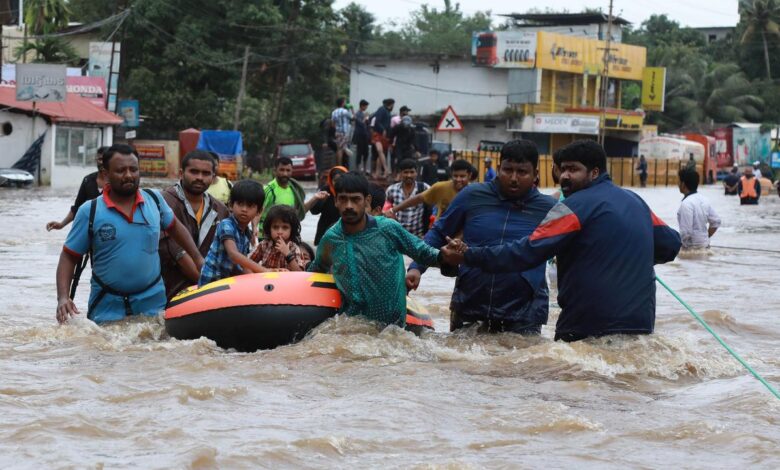
The flooding in Vijayawada, starting in the first week of September 2024, was one of the worst due to incessant heavy rains and discharges from major water bodies such as the Krishna River and Budameru canal. A detailed breakdown of events and their response is hereby given over a period of five days.
Day 1: August 31 – September 1
Heavy rainfall:
A record rainfall of 27 percent in excess of annual average was received by the region, leading to unprecedented flooding in Vijayawada.
City submerged:
As high as 40% of Vijayawada was submerged in water, especially those areas that are generally known as low-lying, like Ajit Singh Nagar and Jakkampudi.
Prakasam Barrage:
As high as 1.18 million cusecs of water were discharged from Prakasam Barrage contributing to floods.
Road and rail disruptions:
Flooded roads and submerged rails disrupted around 100 train services, cancelling and diverting many of them.
Evacuation:
Thousands of people were shifted from their homes to temporary shelters in schools and public buildings.
Disruption of Electricity Supply:
Large swaths of the city were without power due to waterlogged electrical installations.
Rescue operations were mounted by the teams of NDRF and SDRF, who used boats to shift the stranded residents. Casualties: Nine people lost their lives due to different rain-related incidents, while fears grew over the missing ones.
Day 2 (September 2):
Worst rainfall in 50 years:
Vijayawada has received the highest rain in five decades as the city is submerging further.
CM visit:
CM Chandrababu Naidu personally visited the affected areas, supervised the relief works and toured Ajit Singh Nagar.
Relief camps:
Temporary relief camps were thrown open at several places and food was distributed among the people in different shelters to over 100,000 affected persons.
Water release scare:
With more water being released from Prakasam Barrage, the prospect of more water gushing into the lower areas frightened many of a recurring nightmare of floods.
Disruption of the train service:
Heavy flood in the South Central Railway zone due to heavy rain forced the cancellation of additional train services.
Communication with PM Modi:
In communication with Naidu, Prime Minister Modi assured all possible assistance in dealing with the disaster.
Severe water-logging:
A number of areas were submerged in water coming up to knee level. It caused problems in the mobility of the people as well as relief workers.
Evacuation on :
Evacuation works continued as more numbers of families were shifted to the relief shelter with rise in the water level.
Day 3-September 3:
Repairs at the breach to Budameru canal:
Repairs at the breached Budameru canal began and out of the three major breaches, two were sealed.
High water levels:
Though there was some improvement, the water level was still high in many areas beyond the reach of full rehabilitation.
Restoration of power:
Due to floods, large areas were without electricity as restoration of power became a priority.
Damaged infrastructure:
Since all major infrastructures, like roads and bridges, were submerged in water, they delayed the recovery process.
Grousing locals:
Many victims of floods are considerably dissatisfied with the rehabilitation process being too slow amongst those who lost homes and livelihoods.
Challenges with relocation:
People have faced difficulties in relocation since the area did not come under any warning system regarding flooding, and the relief camps lack facilities.
The IMD had forecast continued rainfall in parts of Andhra Pradesh, raising the spectre of prolonged flooding.
Day 4: September 4:
The level of water starts to recede:
A partial recession of the water level was reported in some areas, while much of the city remained submerged.
Continued canal repairs:
Repairs on Budameru canal progressed amidst engineers working on closing remaining breaches.
Power and water restoration:
Efforts were being made to restore essential services, though most of the areas still remained without power.
Rescue operations:
Rescue operations were still in operation as more areas were getting cleared off from water and residents being relocated.
Property damage:
Residents claimed major losses of property comprising homes, items and machinery.
Rehabilitation:
The focus shifts with the local authorities planning long-term rehabilitation for communities affected by floods with infrastructure repairs.
Encroachment issues:
Again, the floods revived debates over encroachments along the canals and other flood sources. Government officials blame the illegal constructions as increasing the damages caused by the floods.
Army assistance:
The Army engineers have been deployed to assist the repairs of canals and management of floods.
Day 5 (September 5):
Further receding of water:
In some areas of Vijayawada, the water level receded considerably, even though floodwater remained in the low-lying areas.
Completion of canal repairs:
The Budameru canal breaches have been completed with repairing of two out of the three breaches. These repairs were done to fully drain excess water.
Relief operations increase:
Relief operations were in full swing with food, water, and medicine being distributed in the affected areas.
Problems in housing:
There were problems with housing as due to the flood damage most of the families could not go back home and were still living in temporary shelters.
Livelihood impacts:
Business and livelihood activities in these areas of flooding were severely affected and many have asked the government for compensation. Army involvement: Army engineers continued their work on sealing the remaining breaches in the Budameru canal.
health concerns:
The flooded area saw a rise in concern over outbreaks due to waterborne diseases. Reconstruction planning: Government officials planned long-term rehabilitation efforts, including better drainage and flood prevention.
Current Situation:
As of early September 2024, the relief is on and unabated, though replete with an array of challenges. Restoration of basic services and repair of damaged infrastructure has been the primary concern of the government. Encroachments along Budameru and poor flood management planning have been cited as major factors that have exacerbated this disaster. For the first time, long-term proposals for flood management have been drawn up, which include expanding drainage systems and reinforcing water bodies to prevent flooding in the future.




